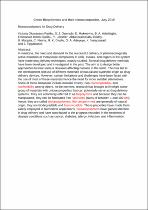JavaScript is disabled for your browser. Some features of this site may not work without it.
- ResearchSpace
- →
- Research Publications/Outputs
- →
- Book Chapters
- →
- View Item
| dc.contributor.author |
Fasiku, VO

|
|
| dc.contributor.author |
Owonubi, SJ

|
|
| dc.contributor.author |
Mukwevho, E

|
|
| dc.contributor.author |
Aderibigbe, B

|
|
| dc.contributor.author |
Sadiku, E

|
|
| dc.contributor.author |
Lemmer, Yolandy

|
|
| dc.contributor.author |
Reddy, AB

|
|
| dc.contributor.author |
Manjula, B

|
|
| dc.contributor.author |
Nkuna, C

|
|
| dc.contributor.author |
Dludlu, MK

|
|
| dc.date.accessioned | 2019-11-28T08:18:29Z | |
| dc.date.available | 2019-11-28T08:18:29Z | |
| dc.date.issued | 2019-07 | |
| dc.identifier.citation | Fasiku, V.O. (et.al). 2019. Bionanopolymers for drug delivery. Green Biopolymers and their Nanocomposites, pp 191-220 | en_US |
| dc.identifier.isbn | 978-981-13-8063-1 | |
| dc.identifier.isbn | 978-981-13-8062-4 | |
| dc.identifier.uri | https://link.springer.com/chapter/10.1007/978-981-13-8063-1_8 | |
| dc.identifier.uri | https://doi.org/10.1007/978-981-13-8063-1_8 | |
| dc.identifier.uri | https://www.springer.com/gp/book/9789811380624 | |
| dc.identifier.uri | http://hdl.handle.net/10204/11238 | |
| dc.description | Copyright: 2019 Springer. Due to copyright restrictions, the attached PDF file only contains the abstract of the full text item. For access to the full text item, kindly consult the publisher's website. | en_US |
| dc.description.abstract | In medicine, the need and demand for the successful delivery of pharmacologically active materials or therapeutic compounds to cells, tissues, and organs in the system have made drug delivery techniques broadly studied. Several drug delivery methods have been developed and investigated in the past. The aim is to design better approaches to treat various diseases affecting humans in the world. This has led to the development and use of different materials of natural and synthetic origin as drug delivery devices. However, certain limitations and challenges have been faced with the use of most of these materials hence the need for more suitable alternatives. Some of these limitations include material toxicity, non-biocompatibility, and nonflexibility among others. At the moment, research has brought to limelight some group of materials with unique properties that can potentially serve as drug delivery systems. They are commonly referred to as biopolymers and because they can be manipulated, they can be fabricated into nanosizes (sizes of between 1 and 100 nm); hence, they are called bionanopolymers. Bionanopolymers are generally of natural origin, they are biodegradable and biocompatible. These properties have made them widely employed in biomedical applications. Bionanopolymers have gained attention in drug delivery and have contributed to the progress recorded in the treatment of disease conditions such as cancer, diabetes, allergy, infection, and inflammation. | en_US |
| dc.language.iso | en | en_US |
| dc.publisher | Springer | en_US |
| dc.relation.ispartofseries | Worklist;22831 | |
| dc.subject | Drug delivery | en_US |
| dc.subject | Material toxicity | en_US |
| dc.subject | Non-biocompatibility | en_US |
| dc.title | Bionanopolymers for drug delivery | en_US |
| dc.type | Book Chapter | en_US |
| dc.identifier.apacitation | Fasiku, V., Owonubi, S., Mukwevho, E., Aderibigbe, B., Sadiku, E., Lemmer, Y., ... Dludlu, M. (2019). Bionanopolymers for drug delivery., <i>Worklist;22831</i> Springer. http://hdl.handle.net/10204/11238 | en_ZA |
| dc.identifier.chicagocitation | Fasiku, VO, SJ Owonubi, E Mukwevho, B Aderibigbe, E Sadiku, Yolandy Lemmer, AB Reddy, B Manjula, C Nkuna, and MK Dludlu. "Bionanopolymers for drug delivery" In <i>WORKLIST;22831</i>, n.p.: Springer. 2019. http://hdl.handle.net/10204/11238. | en_ZA |
| dc.identifier.vancouvercitation | Fasiku V, Owonubi S, Mukwevho E, Aderibigbe B, Sadiku E, Lemmer Y, et al. Bionanopolymers for drug delivery.. Worklist;22831. [place unknown]: Springer; 2019. [cited yyyy month dd]. http://hdl.handle.net/10204/11238. | en_ZA |
| dc.identifier.ris | TY - Book Chapter AU - Fasiku, VO AU - Owonubi, SJ AU - Mukwevho, E AU - Aderibigbe, B AU - Sadiku, E AU - Lemmer, Yolandy AU - Reddy, AB AU - Manjula, B AU - Nkuna, C AU - Dludlu, MK AB - In medicine, the need and demand for the successful delivery of pharmacologically active materials or therapeutic compounds to cells, tissues, and organs in the system have made drug delivery techniques broadly studied. Several drug delivery methods have been developed and investigated in the past. The aim is to design better approaches to treat various diseases affecting humans in the world. This has led to the development and use of different materials of natural and synthetic origin as drug delivery devices. However, certain limitations and challenges have been faced with the use of most of these materials hence the need for more suitable alternatives. Some of these limitations include material toxicity, non-biocompatibility, and nonflexibility among others. At the moment, research has brought to limelight some group of materials with unique properties that can potentially serve as drug delivery systems. They are commonly referred to as biopolymers and because they can be manipulated, they can be fabricated into nanosizes (sizes of between 1 and 100 nm); hence, they are called bionanopolymers. Bionanopolymers are generally of natural origin, they are biodegradable and biocompatible. These properties have made them widely employed in biomedical applications. Bionanopolymers have gained attention in drug delivery and have contributed to the progress recorded in the treatment of disease conditions such as cancer, diabetes, allergy, infection, and inflammation. DA - 2019-07 DB - ResearchSpace DP - CSIR KW - Drug delivery KW - Material toxicity KW - Non-biocompatibility LK - https://researchspace.csir.co.za PY - 2019 SM - 978-981-13-8063-1 SM - 978-981-13-8062-4 T1 - Bionanopolymers for drug delivery TI - Bionanopolymers for drug delivery UR - http://hdl.handle.net/10204/11238 ER - | en_ZA |






